|























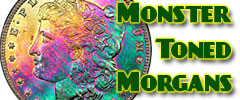
View the largest gallery of high-end and
Monster rainbow toned Morgan dollars, an informational guide
on how to tell natural vs. artificial toning, learn to price
toned Morgans, view auction results of rainbow Morgans, and
view what characteristics to look for in high-end toned
rainbow Morgan dollars.


Need to contact us quickly? Send us an email by
Clicking Here.


Click Here
to view all of the coins that we've sold since
the website was launched in January 2010.

How to Grade Coins
Frequently Asked Questions
Numismatic Articles
Numismatic Glossary of Terms
Coin Supplies
Comprehensive List of Numismatic Reference Guides





NGC - Numismatic
Guaranty Corporation is based out of Sarasota
Florida and is one of the top 2 grading companies
for US Coins, Patterns, and Medals. It is one of the
two preferred grading companies by jhonecash.com.
PCGS
- Professional Coin Grading Service is based out of Newport
Beach, CA and is one of the top 2 grading companies for US
Coins, Patterns, and Medals. It is one of the two preferred
grading companies by jhonecash.com.
US
Mint - The US Mint is where you can get information
regarding modern US coins and can order directly from the US
Mint.
Collectors Universe Coin Forum - This is the
pulse of the Numismatic market. Join and interact with tens
of thousands of other collectors and dealers.
American
Numismatic Association - The ANA was started in 1891
and is focused on providing collectors with information and
advancing the numismatic knowledge of the collecting
community.
|
 |
High-End and Monster Toned Morgan
Dollar Gallery
Back to Top
|
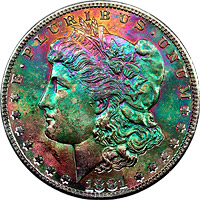 |
 |
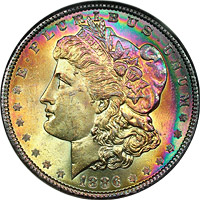 |
"Forest Fire"
1881-S $1 PCGS MS63
$2,150 |
"Southern Cross"
1883-O $1 PCGS MS65 CAC
$3,750 |
"Aura"
1886 $1 NGC MS64* STAR CAC
$1,650 |
|
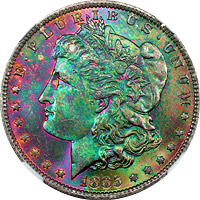 |
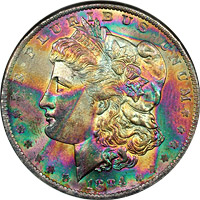 |
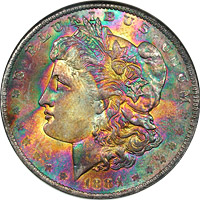 |
"Darth Verde"
1885 $1 NGC MS65
$2,450 |
"Wild Endroller Twin Pair from the Same
Roll"
1884-O $1 NGC MS64* STARS
$3,000 (pair) |
|
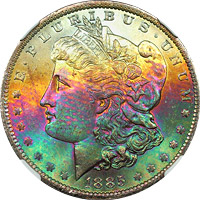 |
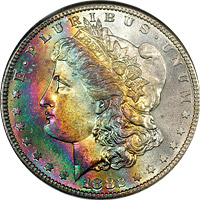 |
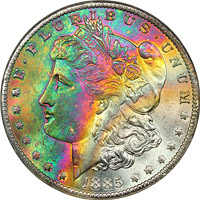 |
"Textile Summer"
1885-O $1 NGC MS65* STAR
$3,000 |
"Rainbow Tide"
1882-S $1 NGC MS67* STAR
NOT AVAILABLE |
"Irish Rainbow"
1885-O $1 NGC MS66* STAR
NOT AVAILABLE |
|
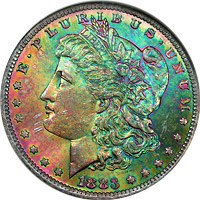 |
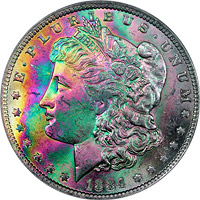 |
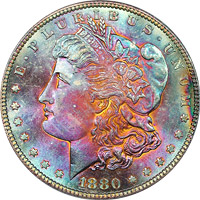 |
"St. Elmo's Fire"
1883-O $1 NGC MS64
NOT AVAILABLE |
"Evil Sister"
1884-O $1 PCGS MS64
NOT AVAILABLE |
"Pink Princess"
1880-S $1 PCGS MS66 (ICG 67)
NOT AVAILABLE |
|
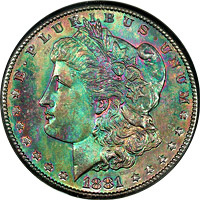 |
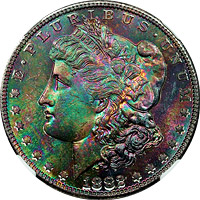 |
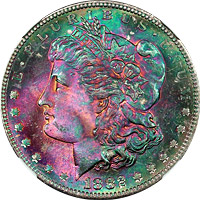 |
"Green Goblin"
1881-S $1 NGC MS64
NOT AVAILABLE |
"Lizard Mirrors"
1882-S $1 NGC MS66
NOT AVAILABLE |
"Greengenta"
1882-S $1 NGC MS66
NOT AVAILABLE |
|
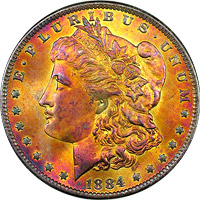 |
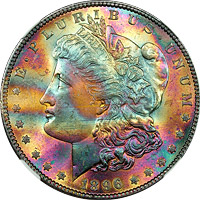 |
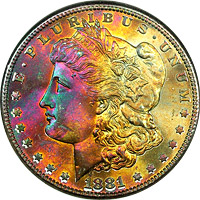 |
"Magma"
1884-O $1 NGC MS65*
NOT AVAILABLE |
"Supernova"
1896 $1 NGC MS65*
NOT AVAILABLE |
"Blushing Volcano"
1881-S $1 NGC MS66*
NOT AVAILABLE |
|
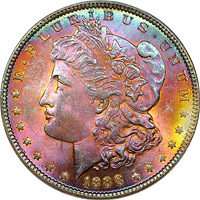 |
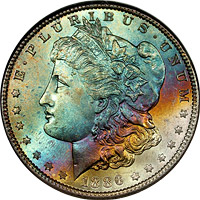 |
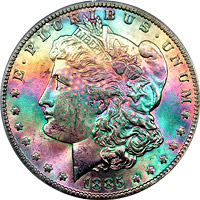 |
"Barbie"
1888 $1 ANACS MS63
NOT AVAILABLE |
"Arctic Endroller"
1886 $1 NGC MS67
NOT AVAILABLE |
"Tex-Mex"
1885-O $1 PCGS MS64 CAC
NOT AVAILABLE |
|
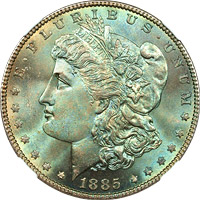 |
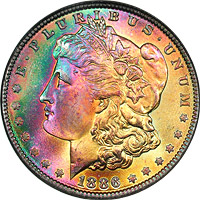 |
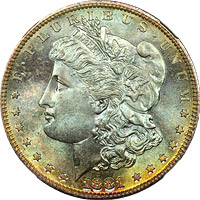 |
"Blue Suede Superb Gem"
1885 $1 NGC MS67
NOT AVAILABLE |
"Oasis"
1886 $1 NGC MS64* STAR
NOT AVAILABLE |
"Icy Perfection"
1881-S $1 NGC MS67* STAR
NOT AVAILABLE |
|
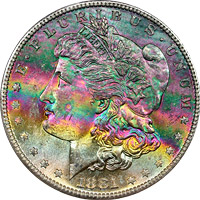 |
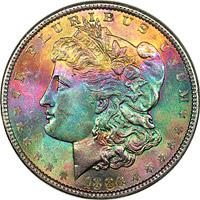 |
 |
"Beauty Mark"
1881-S $1 PCGS MS65
NOT AVAILABLE |
"Rainbow Flow"
1886 $1 NGC MS65
NOT AVAILABLE |
"Nightshade"
1881-S $1 PCGS MS65
NOT AVAILABLE |
|
 |
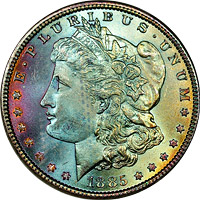 |
 |
"Rocky"
Capital Plastics Holder MS64
NOT AVAILABLE |
"Bluegill"
1885 $1 NGC (0ld) MS65
NOT AVAILABLE |
"Hibiscus"
1881-S $1 PCGS MS63
NOT AVAILABLE |
|
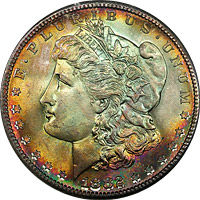 |
 |
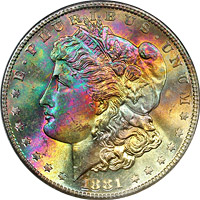 |
"Salamander"
1882-S $1 (Old) NGC MS67 CAC
NOT AVAILABLE |
"Marmalade Mirrors"
1881-S $1 PCGS MS64+
NOT AVAILABLE |
"Annabel Lee"
1881-S $1 PCGS MS66
NOT AVAILABLE |
|
 |
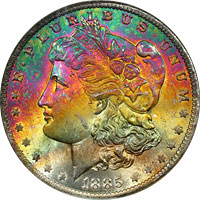 |
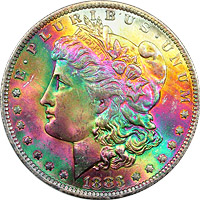 |
"Spring Fling"
1886 $1 PCGS MS66
NOT AVAILABLE |
"Dayo"
1885 $1 NGC MS65
NOT AVAILABLE |
"Kool-Aid"
1883-O $1 ICG MS65
NOT AVAILABLE |
|
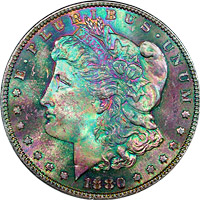 |
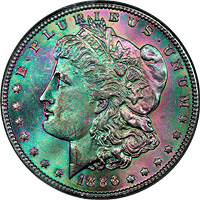 |
 |
"Green Ghost"
1880-S $1 PCGS MS65
NOT AVAILABLE |
"Deep Ellum"
1886 $1 NGC MS63* STAR
NOT AVAILABLE |
"Shockwave"
1886 $1 NGC MS64* STAR
NOT AVAILABLE |
|
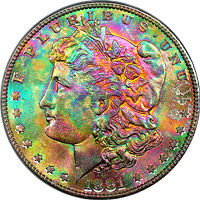 |
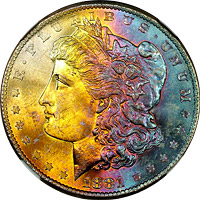 |
 |
"Medusa"
1881-S $1 PCGS MS66 CAC
NOT AVAILABLE |
"Twilight"
1881-S $1 NGC MS66* STAR
NOT AVAILABLE |
"Green Flash"
1881-S $1 PCGS MS65
NOT AVAILABLE |
|
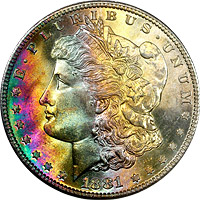 |
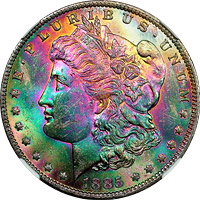 |
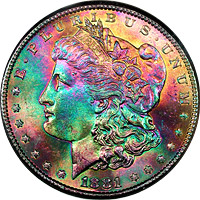 |
"Lofty Rainbow"
1881-S $1 PCGS MS68 CAC
NOT AVAILABLE |
"Springtime"
1885-O $1 NGC MS63* STAR
NOT AVAILABLE |
"Texas Tea"
1881-S $1 NGC MS66* STAR CAC
NOT AVAILABLE |
|
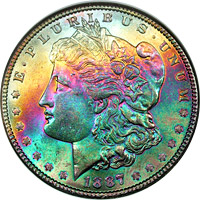 |
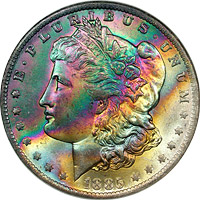 |
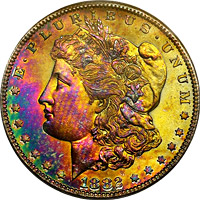 |
"California Sunshine"
1887 $1 NGC MS65* STAR
NOT AVAILABLE |
"Blueberry Monster"
1885-O $1 NGC MS65 CAC
NOT AVAILABLE |
"Midnight Carnival"
1882-S $1 PCGS MS66 CAC
NOT AVAILABLE |
|
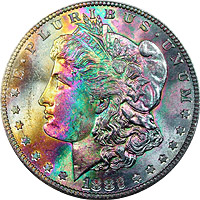 |
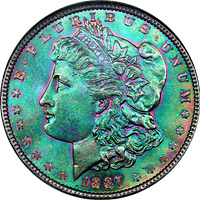 |
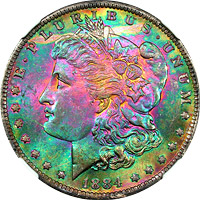 |
"Deep River"
1882-S $1 PCGS MS65 - CAC
NOT AVAILABLE |
"Hopi Jewel"
1887 $1 NGC MS65* STAR CAC
NOT AVAILABLE |
"Watermelon Burst"
1884-O NGC MS64* STAR - CAC
NOT AVAILABLE |
|
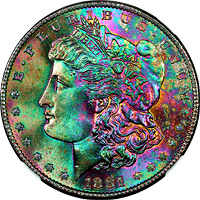 |
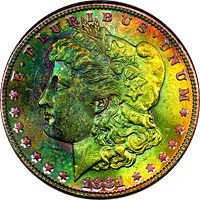 |
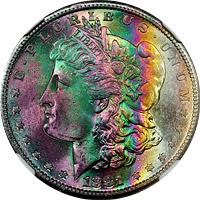 |
"Black Magic"
1881-S $1 NGC MS66* STAR
NOT AVAILABLE |
"Green Hornet"
1881-S $1 NGC MS65
NOT AVAILABLE |
"Emerald City"
1881-S $1 NGC MS66* STAR
NOT AVAILABLE |
|
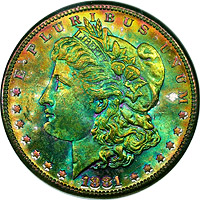 |
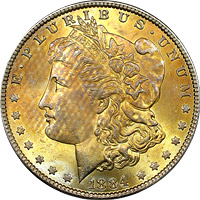 |
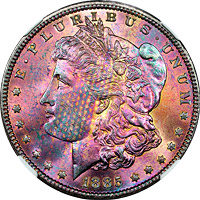 |
"Green Meanie"
1881-S $1 NGC MS65
NOT AVAILABLE |
"Golden Freckles"
1884 $1 PCGS MS63
NOT AVAILABLE |
"Mauve Freckles"
1885 $1 NGC MS64
NOT AVAILABLE |
|
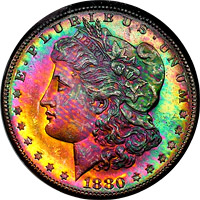 |
 |
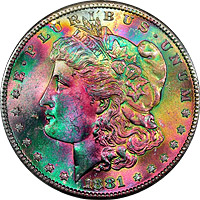 |
"Christmas Tree"
1880-S $1 NGC MS66* STAR
NOT AVAILABLE |
"Black Mamba"
1880-S $1 NGC MS66* STAR
NOT AVAILABLE |
"Chili Pepper"
1881-S $1 NGC MS66* STAR
NOT AVAILABLE |
|
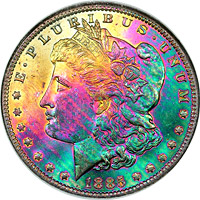 |
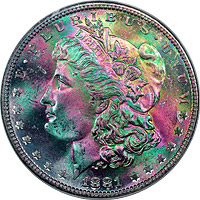 |
 |
|
"Electric Rain"
1885-O $1 NGC MS64* STAR
NOT AVAILABLE |
"Santeria"
1881-S $1 PCGS MS65
NOT AVAILABLE |
"Lightning Bolt"
1881-S $1 NGC MS65* STAR PL
NOT AVAILABLE |
|
|
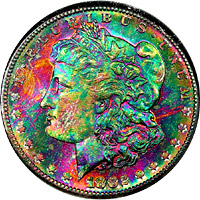 |
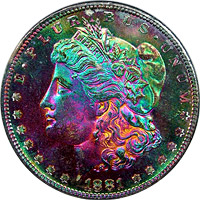 |
 |
"Scrunchie"
1882-S $1 NGC MS67* STAR
NOT AVAILABLE |
"Black Opal"
1881-S $1 PCGS MS65+ CAC
NOT AVAILABLE |
"Mayan Jewel"
1881-S $1 PCGS MS64
NOT AVAILABLE |
|
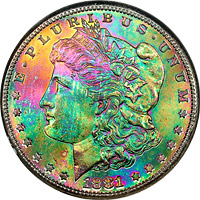 |
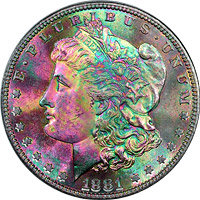 |
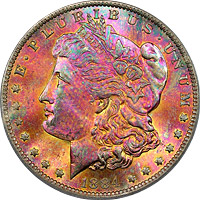 |
"Pop Monster"
1881-S $1 NGC MS66* STAR
NOT AVAILABLE |
"Wicked"
1881-S $1 PCGS MS66 CAC
NOT AVAILABLE |
"Textile Fire"
1884-O $1 PCGS MS65 CAC
NOT AVAILABLE |
|
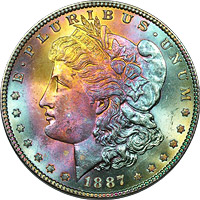 |
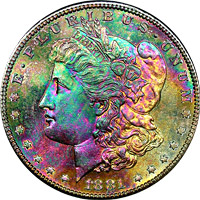 |
 |
"Sunshine"
1887 $1 PCGS MS65
NOT AVAILABLE |
"Double Trouble"
1881-S $1 PCGS MS66
NOT AVAILABLE |
"Forest Fire"
1881-S $1 PCGS MS63
NOT AVAILABLE |
|
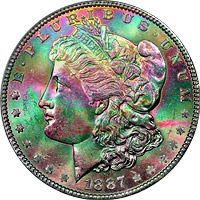 |
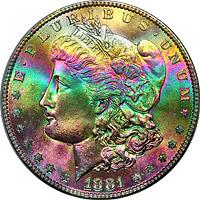 |
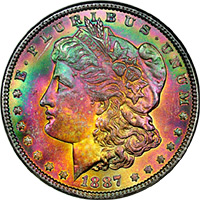 |
"Almost There"
1887 $1 PCGS MS64
NOT AVAILABLE |
"The Moose"
1881-S $1 PCGS MS68
NOT AVAILABLE |
"Nuclear Meltdown"
1887 $1 NGC MS65* STAR
NOT AVAILABLE |
|
Rarity of Monster Toned Morgan Dollars
Back to Top
The rarity of true monster toned Morgan dollars
cannot be stressed enough. Out of the 656,900,590
Morgan dollars that were produced from 1878 through
1921, there are probably in the ballpark of about
10,000 "Rainbow Morgan dollars". This quantity
represents any morgan with even the slightest amount
of rainbow color. The battlecreek collection alone
had something like 1,400 but the vast majority were
just slivers of thin crescents. NGC nevertheless
still put a star on them, which in my opinion,
cheapened the value of the STAR * designation.
Out
of the 10,000 or so "Rainbow Morgans" about 75%
(7,500) of them are not even close to being
considered monsters. Out of the remaining 2,500,
about 75% of those morgans (1,875), is where we get
into the Rainbow Morgan dollars that are actually
attractive but many may have something hampering the eye
appeal of the coin keeping it from being a monster.
I will go through in detail these characteristics.
Many people buy coins in this range believing they
are the most beautiful coins they have ever seen.
The problem is, they have not seen the remaining 625 morgans out of the original 656 Million + mintage of
morgans that serve as a benchmark for monster and
near-monster morgans. Out of that 625 that are
incredibly attractive, only about 200 of them would
qualify as a Monster toned Morgan.
It is all
subjective of course but auction prices don't lie,
and the top 200 are universally agreed upon as the
most stunning Toned Morgan Dollars in existence. The
table below is just based on my observations of
handling high-end toned coins and Morgan dollars but
if anyone has any better estimations or reasons why
my estimations might be incorrect, I would implore
them to contact me.
brandon@jhonecash.com
| 656,900,590 |
Total Mintage of Morgan
Dollars 1878-1921 |
| 10,000 (.000015%) |
Estimation of Toned Morgans
in Existence |
| 7,500 (.0000114%) |
Estimation of Low-End Toned
Morgans in Existence |
| 1,875 (.0000028%) |
Estimation of Medium Toned
Morgans in Existence |
| 625 (.00000095%) |
Estimation of High End Toned
Morgans in Existence |
| 200 (.00000030%) |
Estimation of Monster Toned
Morgans in Existenc |
How Morgan Dollars Toned
Back to Top
The Morgan Silver Dollar, produced
from 1878 until 1904 and again in 1921 were in heavy
supply and many more were struck than were required
for circulation. Therefore, many of the freshly
struck examples were stored at the US Treasury in
canvas bags until they were eventually released or
sold to the public during the GSA (General Services
Administration). Other hoards, including the Battle
Creek and the Continental Bank Hoard produced
many incredibly toned coins as well. These coins sat in canvas bags for
nearly a century. During that time, the coins
closest to the canvas of the bag or near the top of
the bag were constantly bombarded by a minute
concentration of sulfur. Sulfur was infused in the
canvas bags in an attempt to reduce the damage
caused by rats chewing on them.
The
silver reacted with the sulfur to form a thin film
of silver-sulfide on the surface of the coins, which
reflects and refracts the light so that we see the
colors of the rainbow on the coins' surface. This
phenomenon is known as thin-film interference. This
is much different than "oxidation" which implies a
reaction with oxygen. Silver-oxide presents itself
as a grey haze. Now, depending on how thick the
silver-sulfide film is, determines which colors are
absorbed and which are reflected. That is how we get
bands of rainbow color on many toned Morgans. A
constant thickness of film on the surface produces
monochromatic toning. The deeper the patina, or the
thicker the film, reduces the amount of light
reflected and increases the colors absorbed by the
patina which is why the toning progression ends up
with a terminal charcoal band. Now, not all toned
Morgans were toned in canvas bags but the thin-film
interference phenomenon is still in play.
Visual illustration of thin-film interference by
Doug Kurz
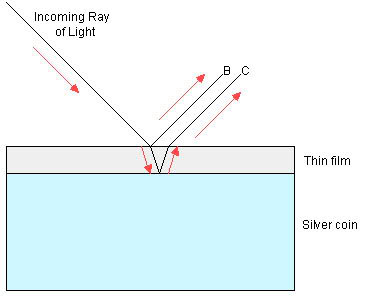
Since the physics behind thin-film interference as
it pertains to toned Morgans is quite extensive,
please refer to this article authored by Doug Kurz
(Sunnywood) and compiled by Brandon Kelley.
Wikipedia Article on thin-film interference
Some of the prooflike Morgan
dollars were stored along with other proofs of the
day and toned similarly such as "The Lightning
Bolt". Others were put into the popular "Wayte
Raymond" albums which had a high concentration of
sulfur in the cardboard causing the coins to tone in
"Target Patterns". This is because the
sulfurous compounds were on the rims of the coin and
the toning progressed inward. Others were stored in Kraft
envelopes which also had concentrations of sulfur
creating "Envelope Toned" examples with two sided
toners that are simply spectacular and typically
break some of the rules for naturally toned coins. This type
of toning produced dual sided target patterns that
resemble album toning and are usually accompanied
with nasty haze. The sulfurous material in the
envelopes surrounded the coin so the toning covers
the entire coin.
The
aforementioned toning methods for NT Morgans are the
most commonly accepted. If a Toned Morgan dollar
surfaces with strange toning and there is no way to
validate how it toned that way, it is generally
accepted that the toning may have been accelerated
or artificially done. However, if a strangely toned
Morgan dollar comes into the market with a history
that is verifiable and answers the question of how
the coin toned, it will be accepted as a naturally
toned coin and is usually highly prized as a unique
treasure by many collectors.
Types of Rainbow Toned Morgans
|

(Typical Color Progression of
the Majority of Natural Bag Toned Morgan Dollars)

(Pastel Spectrum Toning
Progression)

(Doug Kurz Rendition of Color Progression of
Thin-Film Interference on Bag Toned Morgans)
Read more about Doug Kurz (Sunnywood's)
Color Classification system in this
outstanding article
|
| Different parts of the color
spectrum can be stretched and shortened
depending on the conditions in which the
Morgan dollar toned. Additionally, these
colors can be either muted or fabulously
vibrant depending on the surface type and
thickness of the patina but all naturally
toned Morgans follow this progression. Some
examples can be deceiving because the color
will appear to be missing a band between
colors. Look closely to see if the missing
color is just simply a super-thin band in
that particular coin's spectrum. Check in
the recessed areas such as the curls of the
hair (if the area in question is over her
hair) and see if the missing band is present
in the nooks and crannies. Now, since
the above pictured color bands come in all
shapes, sizes, and vibrancies, I'll take the
initiative to group the main types of
Rainbow toned Morgans. Keep in mind
that the emerald and burgundy bands in the
spectrum tend to repeat before retreating into the
terminal charcoal band. Notice that the
pastel spectrum appears a mirror image of the
beginning half of the regular spectrum. In
Doug Kurz's model, the spectrum repeats in
four cycles ending in a terminal cycle of
violet and charcoal:
For more information about
the toning spectrum of toned Morgans, refer
to this article authored by Doug Kurz
regarding an analysis of the spectrum cycles
of toned Morgan dollars
|
Thin Film
Interference Color
Progression

(first cycle)

(second cycle)

(third cycle)

(fourth cycle)

(fifth/terminal
cycle)
|
Doug Kurz's model is
more advanced but reveals the tiny
bands that sometimes are stretched
out by the toning process and
expanded across the coin like the
intermingled with green in the third
cycle which is seldom prominent.
Example of first
to terminal cycle:
 |
|
|
Example of the
first cycle:
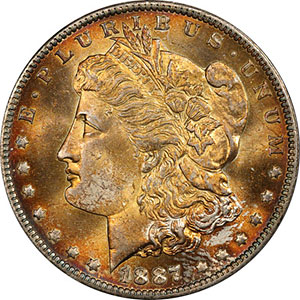 |
Example of the
second cycle:
 |
|
|
Example of the
rare third cycle greens & yellows:
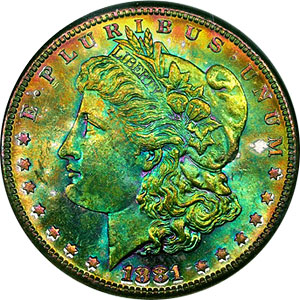 |
Example of fourth
cycle:
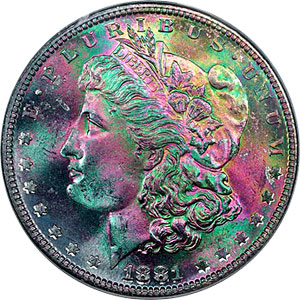 |
|
|
Three Main Spectrum Groups
|
|
Pastel Spectrum



As you can see the array of colors is all
from the earliest progressions of color as
the Morgan begins to tone. These are also
known as sunset colors or shades that are
reminiscent of Easter or a tropical beach at
sunset. Many of these examples display
profound luster as the level of patina has
not built up very thick. The deeper the
layer of patina is on the surface, the
deeper the spectrum of color displayed on
the coin. |
Neon Spectrum


This grouping of colors is neon in nature
and the turquoise is an amalgam of both the
blue and green spectrums. It was created by
being close to the canvas bag where bands of
blue floated across the neon green band
giving it a blue/green or turqoise look.
This is a VERY desirable portion of the
spectrum and is typically very short on the
majority of Rainbow Morgans. Finding
examples of this spectrum with exceptional
luster drives my passion for Toned Morgans.
These coins stand out like headlights! |
Black Spectrum


This spectrum color runs from upper right
to lower left starting with a blue-green
from the neon spectrum to the terminal
"charcoal" color in the lower left. This is
the antithesis of the neon spectrum. As the
colors repeat while continuously deepen,
they terminate in a deep charcoal color.
This coin exhibits the black spectrum
vividly. However, many black spectrum coins
have pumpkin orange and a much longer spread
of the entire spectrum present on the coin.
PL examples are exceptionally desirable and
beautiful. |
|
Variations of the Three Spectrum Groups
|
|
Monochromatic
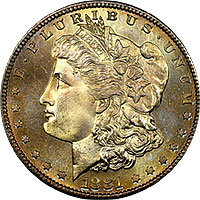
Just as the name implies, it
is simply toned in just one single color.
Try putting together a spectrum set of these
babies. |
Nearly Monochromatic
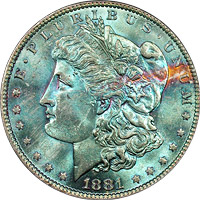
When a coin is nearly
monochromatic, it is nearly completely toned
in one color but may have other colors
present. |
Rim Toned
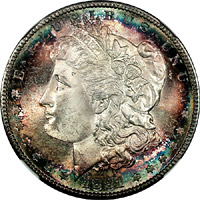
This type of toning is
created from being either in an album or in
a holder with impurities that reacted with
the silver in the Morgan. |
|
|
Crescent
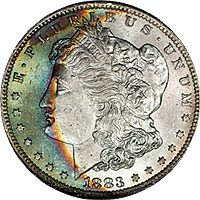
The crescent shape is from a
coin stacked partially on the toned Morgan
as it toned in the canvas bag. A Morgan
dollar sat partially over the surface of
this coin as it toned in the canvas bag.
This is the most common type of Toned Morgan
dollar. |
Multiple-Crescent
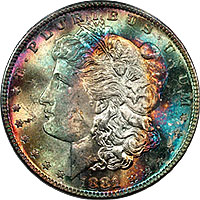
The coin toned in a canvas
bag with a coin stacked over it. The coin
over it then shifted and the coin continued
to tone with a different crescent. Some
multiple crescents result from different
coins covering different areas with no
shifting occurring. |
Greenie
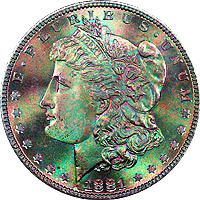
The right humidity levels
and amount of time in a canvas bag created a
certain green spectrum of Morgans that share
this similar look. There are enough of these
around for me to consider them as a
particular grouping. All are desirable. |
|
|
Banded Rainbow

The second most common type
of Rainbow Morgans have a band of rainbow
colors that resulted from the coin being
tilted while it toned allowing more
particulates from the bag to fall heavier on
certain points of the coin corresponding to
the angle of tilt while the coin toned. |
Fireball

This group of coins have a
fiery look to them and are similar in nature
to the way they toned to the greenies except
they toned in a different level of humidity.
These are some of the most striking examples
of Toned Morgans but there are not many out
there. |
End Roller
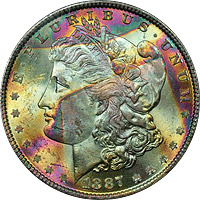
Morgans stored in paper
coin-rolls with the ends of the rolls folded
in over the coin at the end of the roll
developed this striking toning pattern. Haze
is common on these and real monsters with
end-roll toning are exceptionally scarce as
vibrant colors are not common on them.
|
|
|
Sunset

This toning falls into the
pastel spectrum. Many of these develop a
look similar to what many describe as a
tropical beach sunset. Most are very
lustrous because the patina is not as thick
as deeper spectrum toned Morgans. |
Textile

Morgans stored in canvas
bags that were super-close or touching the
actual bag toned with a matching pattern of
the textile on the bag. This pattern is
extremely desirable and exceptionally heavy
textile is exceedingly rare. |
Proof Style

Some Morgans are prooflike
and some collectors stored their examples of
these alongside their other proof coins in
tissue paper to protect the surfaces. This
tissue paper had impurities that toned the
coins a certain way. Super Rare! |
|
|
Album/Envelope
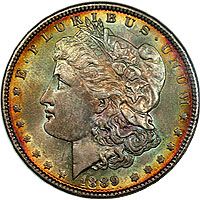
Coins stored in albums and
envelopes are 99% dual sided toning. Similar
colors on both the obverse and reverse blend
into and towards the center. This group is
rare with good luster and are usually
dominated by earthy tones. |
Stormy
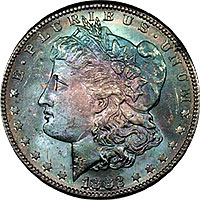
These are Morgans with a
steely blue and and muted magenta colors are
common enough for me to include them here as
a particular group. These coins are
generally pretty but usually low-end as the
color is not very vibrant. |
Variegated

This type of toning is
exactly as it is named. The colors are
varied and flow across the surface in
strange patterns. Many are caused by textile
patterns from the corner of the bag with
threads apparent on the surface. |
|
| |
|
|
Characteristics that make all
the difference when buying Toned Morgans
Back to Top
| 1. Color
(Rarity of Color) |
Obviously, color is a VERY
important consideration when buying toned
coins. However, certain bands of the
spectrum are incredibly rare to find in
copious amounts on a Rainbow Morgan. Green,
Pumpkin Orange, Magenta and Royal Blue are
very desirable colors. Not necessarily
those colors on the same coin though. The
deeper down the color spectrum the colors on
the coin are from, if the luster is still
prominent, the more rich the colors
typically appear and therefore have more eye
appeal and presence which make them more
desirable. |
|
| 2. Pop
Factor |
Pop represents how well the
color "jumps" off the coin. This has alot to
do with the type of surface as well but you
will know color that pops when you see it.
The best examples will appear to be
luminous. |
|
| 3. Surface
Types |
This really is not an
aspect that is positive or negative but
there are four different surface types:
Velvety, Prooflike, Bowl (rare), and Cartwheel.
The 1880-1887 New Orleans mint coins
generally have a velvety color appearance.
The San Francisco mint produced mainly
Cartwheel type but this mint also produced
the majority of Prooflike, Bowl (rare), and
Cartwheel luster Morgans. Deep Mirror
Prooflike Monsters are extremely rare.
Prooflike and bowl luster examples are by
far the most difficult to image and images
of these coins using a scanner produce
nearly black looking images because of the
reflectivity of the surfaces.
Cartwheel = Rolling
luster that flows in bands across the
surface from one end to the other and it
twirls as you spin the coin in the light
like the spokes of a cartwheel.
Velvety = The vast
majority of toned morgans are of this
surface type. While attractive and colorful,
the velvety nature of the surface stifles
the "Pop" factor.
Prooflike and Deep Mirror
Prooflike = flat mirrors in the field
from a fresh or freshly polished die that
have no curve in them out towards the rim.
Bowl = curved mirrors
(like a bowl) up to the edge of the coin.
This type appears like a hybrid of Cartwheel
and Prooflike surface types and is quite
striking in appearance.
Cartwheel
Luster
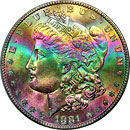
|
Velvety Luster

|
| Prooflike
Luster
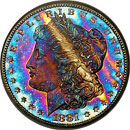 |
Bowl Luster
 |
|
|
| 4. Surface
Preservation |
Contact marks are
distracting. Some more than others. However,
nothing draws attention away from a coin's
color like heavy abrasions in the wrong
spot. Non focal areas are fine to have some
light marks but really heavy marks tend to
make toned morgans less desirable to me.
|
|
| 5. Haze |
Toning is NOT oxidation. It
is Silver Sulfide Film. Haze is Silver
Oxide. Plain
and simple. Not all toning is beautiful and
frequently beautiful toning is blanketed by
an semi-translucent hazy film over the
color. I have seen coins I would have
considered to be monsters if they did not
have an ugly overlay of haze. So, when
buying high-end toned morgans, always
consider haze and try not to buy hazy
toners. They will usually be cheaper and
images can hide haze well that they eye
notices immediately. |
|
| 6. Textile |
Textile is a pattern in the
toning that conformed to the canvas bag the
coin spent nearly a century inside.
Depending on the ferocity of the pattern on
the coin, textile can add multiples to the
value of the coin and usually is what pushes
the coin from being a high-end toner into
the Monster group. Textile is extremely
desirable and quite rare but you can still
pick up textile coins in the low-end
category for very reasonable prices.
 |
|
| 7. Obverse
or Reverse |
Which side the toning is on
makes a HUGE difference. There are more
reverse toned coins out there with beautiful
color because the surface is flatter than
the obverse. There is less elevation between
the fields and highest points of the design
which results in a smoother gradient of the
particular band of the spectrum to flow
across. There are hundreds of reverse toned
Morgans out there that I immediately get
disappointed at when I see them because I
want that color on the obverse where it
flows around Libertys face. Reverse toned
morgans sell for less than half of similarly
toned obverse toned counterparts.
Case in Point: Which One Do You
Like More?
|
| Reverse Toner
 |
Obverse Toner
 |
| If this color
were on the obverse, it would be
worth at least double as it is with
the color on the reverse. This coin
would be a monster if the color were
on the obverse. |
This color is
similar but not quite as nice as the
reverse toner but since the color is
on the obverse, the demand for this
coin is much greater therefore
making it more valuable. |
|
|
| 8. Is it
Real? |
Buy coins graded by PCGS or
NGC. Don't go chasing raw coins on ebay
until you KNOW what you are doing. You WILL
lose alot of money buying "great deals" on
eBay and you won't even realize it until you
try to sell to a knowledgeable dealer. There
are alot of artificially toned coins out
there, some in NGC and PCGS holders. Learn
the ropes by viewing as many nicely toned
morgans as you can before committing to a
coin you suspect may be artificial. I have
an extensive section of this page dedicated
to pointing out AT coins below. |
|
| 9.
Uniqueness |
Some coins will have a
strange uniqueness to them that is
universally appreciated by toned morgan
enthusiasts. Examples like a double crescent
creating a "Cat's Eye" pattern are worth
more because of a striking pattern. Target
toning is usually from albums, envelopes, or
coin cabinets and adds value to the color.
Anything that adds to the eye appeal adds to
the demand for that toner. Anything that
detracts from the eye appeal reduces demand
for that toner.
"The Southern Cross" is a
great example of this quality. The coin is
named so because when you tilt it into a
diffused light source, the image of an
upside down cross is VERY evident. It is
difficult to see in a regular photograph but
jumps out at you via a diffusion photograph.
This also is a good example of how coins can
look different using different photography
methods.
 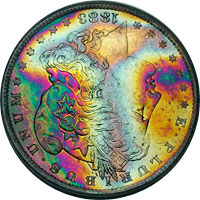 |
|
| 10. Grade |
The pricing for toned
morgans is not linear or directly related to
a coin's grade. An MS64 morgan dollar can be
worth 10 times more than an MS67. However,
superb color on a technically perfect coin
will be worth vastly more than the same
color on a coin with distractions/contact
marks, or strike quality associated with
lower graded coins. |
Naturally Toned (NT) vs.
Artificially Toned (AT)
Back to Top
| 1. Color |
You know, color is an
obvious way to tell if a Morgan dollar is
NT. That goes without saying. The typical
color progression for bag toned Morgan
dollars is: Peach/Orange -->
Powder Blue --> Bright Yellow --> Magenta
--> Royal Blue --> Emerald Green -->
Burgundy (darker magenta) --> Deep Teal -->
Plum --> Charcoal.
Doug Kurz has also developed a color chart
denoting the color progression of a
silver-sulfide thin film interference. This
chart is more advanced than my above color
progression gradient and will help you
determine if those really WILD Morgans that
may be suspect to you might in-fact be AT.
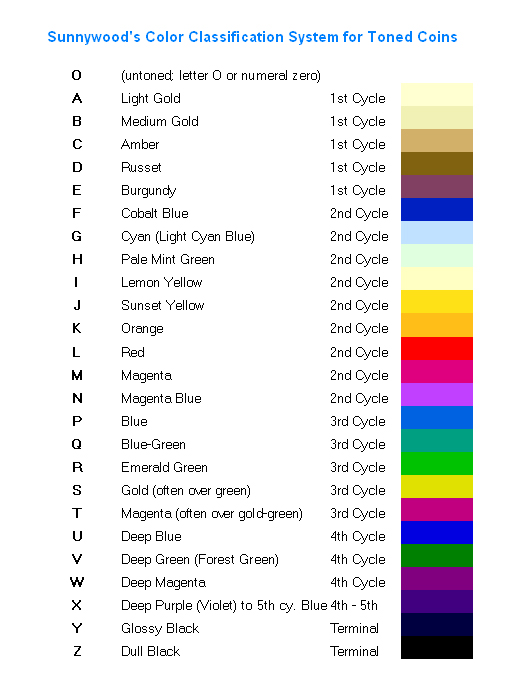
You can read the entire
article explaining this chart in great
detail authored by Doug Kurz (Sunnywood) and
compiled by Brandon Kelley.
After you have seen enough naturally toned
Morgan dollars, you will develop a sense of
what is natural and what is artificial. You
will develop a "spidey-sense" that triggers
a "something just isn't right" feeling
whenever you see an artificially toned
Morgan dollar.

There are unlimited variations of the
thickness of these bands in the color
spectrum. Some color bands completely cover
the obverse in a monochromatic "look". This
is when the thickness of a particular band
of color covers the entire side:
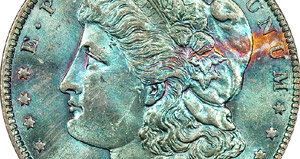
This color progression should exist in
some way shape or form in a naturally toned
Morgan dollar. It's like the coral snake vs.
the king snake. They look similar but the
pattern of colors from the old saying "Red
on Black Venom Lack" and "Red on Yellow Kill
a Fellow". Both snakes have the same colors
but the pattern of color determines which
one can scare you and which one can kill
you.
|
Coral Snake -
Deadly
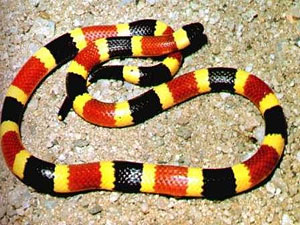
|
King Snake -
Harmless
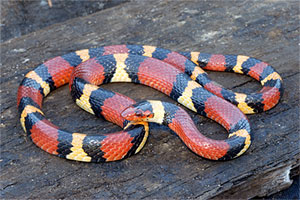
|
Popular colors on Artificially and
Intentionally toned coins are:
- Excessive Blue/Magenta/Purple/Burnt
Orange hues
in billowing shades that do not gradient
evenly. This is created by heating
nickel or by adding a sulfurous compound
to the surface. You can recreate this by
crushing up the yolk of a boiled egg and
keeping it in a container with the coin
for less than 30 minutes. It is obvious,
even to the Toned Morgan Rookie.
- Bands of color with excessive
Pink/Purple hues or colors that
simply do not look natural to someone
armed with the experience of seeing lots
of naturally toned Morgans.
- Sick and pale shades of green
blending with pink are a sad attempt to
recreate the rare green color band but
these are easily distinguishable from NT
coins by focusing on the other
characteristics of NT coins and just
from the inconsistencies in the shade
and layout of the color on the coin.
- I personally have not seen any
artificially toned Morgans that had all
of the proper characteristics but there
is no guarantee there is not at least
one out there. This article is a guide
that is designed to help you identify
artificially toned coins. There are
those out there who believe all toned
Morgans are artificial. That is absurd.
If someone could tone Morgan dollars
into Monster Toners, there would be more
of them out there and their pedigreed
history would not exist.
- Artificially toned Morgans will also
tend to continue toning since the
accelerated methods used to create them
is not stable. Needless to say, if a
coin has been slabbed 10 or even 20
years ago in the first generation PCGS
and NGC holders and it looks the same as
it did the day it was encapsulated, odds
are good that the coin is naturally
toned. Inversely, if a coin has been
slabbed 5 years ago and the color is
fading, deepening, or otherwise
different from when the coin was
encapsulated, odds are good that the
coin was artificially toned.
|
Some AT
examples: I
will be adding more examples here as
I find them. From the images I will
be adding over the next few months,
we should be able to collectively
identify patterns of certain
doctoring techniques and avoid them
and show others what to avoid.
|

You can see the billowing blue,
purple, and burnt orange flowing
across the surface indiscriminate of
the elevation of the detail. Just
the color alone is a dead-giveaway.
Horrible AT |

This one is a little better showing
a touch of elevation chromatics but
take note of the cleaned surface and
the massive amounts of burnt-orange,
blue, and purple. These shades
should not appear in this
progression. |
|
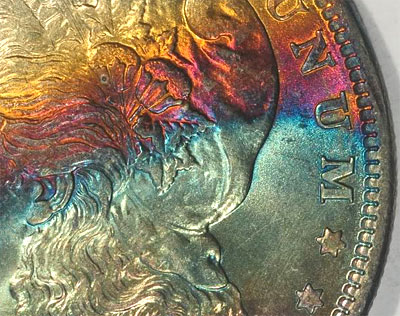
Here is another one similar to the
one at the top-right. This image
shows a coin with several problems.
It is raw and cleaned which you can
see by the hairlines in the field.
The spectrum on this coin is
Orange-Pink-Purple-Royal Blue-Light
Blue. This is NOT the proper color
spectrum of Peach-Light
Blue-Yellow-Magenta-Royal
Blue-Emerald Green. Additionally,
the little piece of foreign material
on the top cotton ball has a bright
halo around it. That may be an
indication of accelerated toning. On
a suspected AT coin, if it has this
"feature", that is another mark
against the coin being natural. |
|
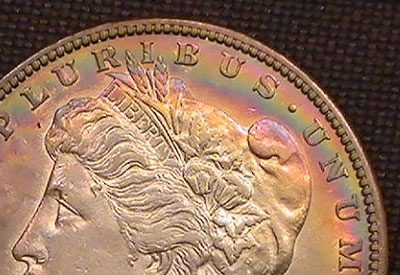
Ugh. If the fact that the coin is
probably a VF and is raw doesn't
raise a red flag, take a look at the
pastel band of color flowing around
the rims. You can see how the color
does not care what elevation of
detail it is at. It just flows right
over PLURIBUS UNUM like it wasn't
there. |
|
|
| 2. Pullaway |
It's a relatively new term
to folks who have not dabbled in Toned
Morgans before. Illustrated below is an
example of pullaway effect. When a Morgan
dollar is struck, the metal is pushed into
the design on the die. Near the edges, the
metal is being moved quite a bit and this
stretching and pushing around the design out
to the rims elongates and linearizes the
metal restricting it's ability to patinate
the way the other metal has around it. A
toned Morgan with this characteristic is
almost undoubtedly naturally toned as AT and
IT methods use accelerated methods to
achieve color will generally not display this
characteristic. However, just because a
Toned Morgan does not have the pullaway
effect, does not necessarily mean the coin
is artificially toned and inversely, just
because a toned morgan exhibits pullaway,
does not mean the coin is NT. However, if it
does have pullaway, odds are good it is NT
but do not let that be the only factor you
check when determining AT/NT.
The vast majority of NT
coins have pullaway
Not all NT coins have pullaway
Pullaway on AT coins is nearly non-existant
Coins with pullaway are NEARLY ALWAYS NT
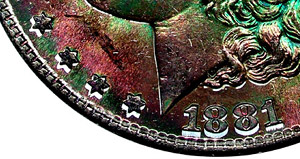
Now, I have seen examples of
AT coins that have pullaway. However, docs
have gotten wind of this characteristic and
will buy coins that have some natural toning
on them with the pullaway and apply AT or IT
processes to put more color on the coin.
Always be wary of your AT spidey sense. If
you see enough naturally toned morgans, when
you see an AT coin, a red flag will go up in
your mind and you will know it is AT.
Develop this sense and you will be fine.
Ignore it, and you will eventually buy an AT
coin. |
|
| 3. Elevation
Chromatics |
Yes, this is a strange term
even to those who have been around Toned
Morgans for awhile. The reason for this is
that I have just coined the term in this
webpage. This term refers to how the color
progression sits on the coin over different
elevations. Artificially toned (AT) coins
and Intentionally toned (IT) coins will have
a different look to the color that alot of
people will notice as strange. Here are two
examples of elevation chromatics:
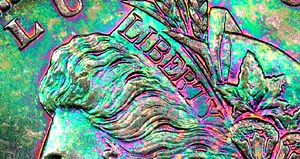
You can see in "LIBERTY" how
the lower elevation of the surface is toned
in a magenta color while the higher
elevation of the coronet around it is toned
in a turquoise green. This is elevation
chromatics. The vast majority of AT coins
will not display this quality and it is a
good benchmark to note when determining NT
vs AT.
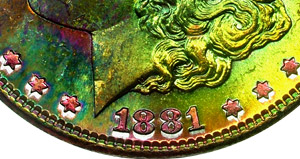
Again, you can see how the
stars are pink/peach while the field around
them flows from blue-green on the left to
chartreuse on the right. This is a perfect
example of elevation chromatics.
|
Examples of Toned Morgan
Dollars of Each Price Range
Back to Top
(These are estimates, no toned
Morgan price is set in stone so if you bought one
that looks like it is from a lower price range than
what you paid and you like the coin, don't get upset
or down. You love the coin, wasn't that the main
factor when you bought it? Remember, these are just
my approximations with an honest margin of error
with individual cases.)
Low-End $40-$150
Low-Mid $100-$200
Mid $150-$300
Mid-High $250-$1000
High $850-$4500
Monster $4000-Sky's the Limit
Highest Price Paid for a
Monster???
I know of one for sure that sold for well over
$30,000.00 but I didn't sell it.
However, it is in the gallery above.
| Low-End Toned
Morgan #1
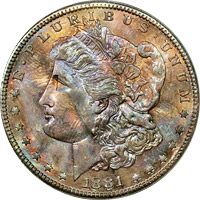 |
Low-End Toned
Morgan #2
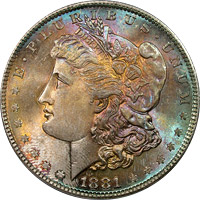 |
|
| Low-End Toned
Morgan #3
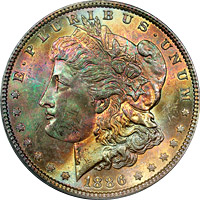 |
Low-End Toned
Morgan #4
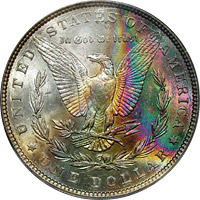 |
|
| Low-End Toned
Morgan #5
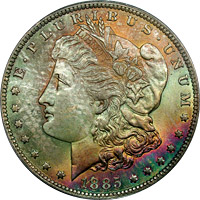 |
Low-Mid Toned
Morgan #1
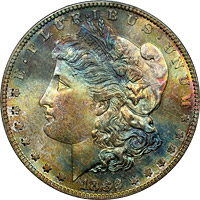 |
|
| Low-Mid Toned
Morgan #2
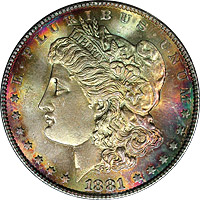 |
Low-Mid Toned
Morgan #3
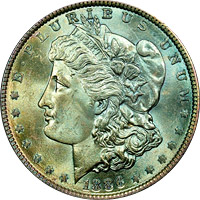 |
|
| Low-Mid Toned
Morgan #4
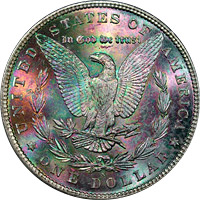 |
Low-Mid Toned
Morgan #5
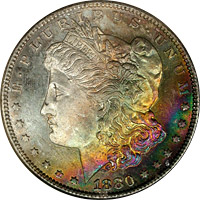 |
|
| Mid Toned
Morgan #1
 |
Mid Toned
Morgan #2
 |
|
| Mid Toned
Morgan #3
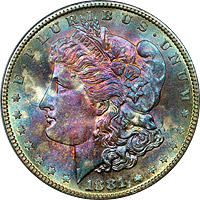 |
Mid Toned
Morgan #4
 |
|
| Mid Toned
Morgan #5
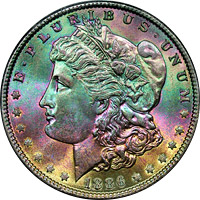 |
Mid-High
Toned Morgan #1
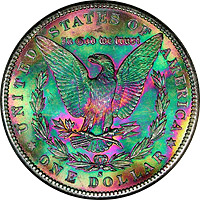 |
|
| Mid-High
Toned Morgan #2
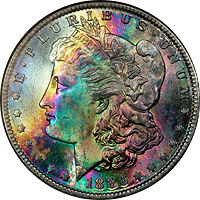 |
Mid-High
Toned Morgan #3
 |
|
| Mid-High
Toned Morgan #4
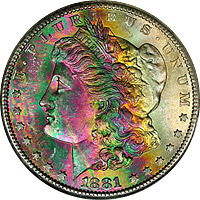 |
Mid-High
Toned Morgan #5
 |
|
| High Toned
Morgan #1
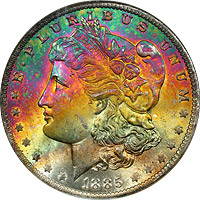 |
High Toned
Morgan #2
 |
|
| High Toned
Morgan #3
 |
High Toned
Morgan #4
 |
|
| High Toned
Morgan #5
 |
Monster Toned
Morgan #1
 |
|
| Monster Toned
Morgan #2
 |
Monster Toned
Morgan #3
 |
|
| Monster Toned
Morgan #4
 |
Monster Toned
Morgan #5
 |
|
| |
|
Heritage Galleries Auction Results for Rainbow
Morgan Dollars
Back to Top
You may recognize some of the coins from the
above list. |












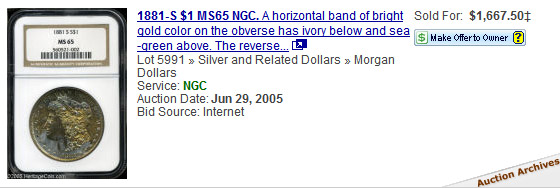
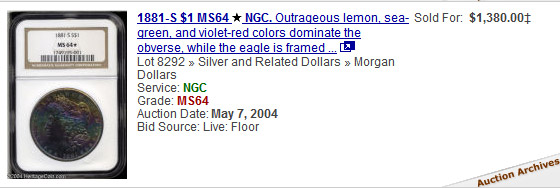









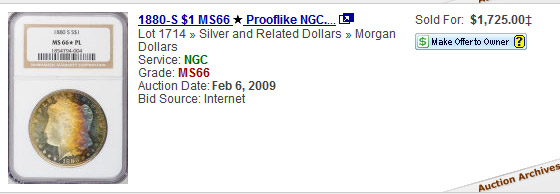







 |
Articles on Toned Coins For Additional
Research
Back to Top
Physics of the Toning
Progression of Rainbow Morgans -
This article by Doug Kurz delves into the physics of Thin
Film Interference and how the human eye perceives the colors
radiating off the surface of a nicely patinated Toned Morgan
dollar. Put your thinking caps on and pull out those old
high-school physics textbooks and enjoy!
Hello
Yellow (Yellow-Gold Toning Spectrums) - This article
addresses the different and varying yellow and gold toning
spectrums of Rainbow Morgan dollars. (Doug Kurz - Sunnywood)
Sunnywood Toning
Classification System - Doug Kurz has developed a
classification system for Toned Morgans based on the
spectrum produced by the thin-film interference phenomenon
caused by the thickness of the silver-sulfide film (patination)
on Toned Morgans. While not widely used by toned coin
enthusiasts, this classification system is extremely helpful
in understanding the toning progression of Rainbow Morgan
dollars. It is also a useful chart to determine if your coin
is artificial by not following the proper color progression.
The Basis of Collecting and Appreciating Naturally Toned
Coins Part 1 - Almost all sophisticated collectors
of U.S. coins have a very strong preference for natural
toning, as opposed to coins that have been artificially
toned, doctored, or dipped in brightening chemical
solutions. As more and more rare coins are becoming subject
to such deliberate, artificial modifications, this issue is
crucial and needs to be urgently addressed. (Sean Reynolds -
Coinlink November 11, 2009)
The Basis of Collecting and Appreciating Naturally Toned
Coins Part 2 - focusing on the connection
between natural toning and the greatest collections, I
emphasize the tradition of strongly preferring naturally
toning, and I point out that naturally toned, 19th century
coins are often not expensive.
(Sean Reynolds - Coinlink
November 17, 2009)
The
Basis of Collecting and Appreciating Naturally Toned Coins
Part 3 - Maintaining that the case for strongly
favoring naturally toned coins goes beyond collector
opinions and tradition. There have always been logical
reasons for determining that coins with natural toning
and/or mostly original surfaces are superior. (Sean
Reynolds - Coinlink Monday, December 7,
2009)
|



































































































































































































